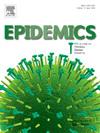Projecting the population-level impact of norovirus vaccines
IF 2.4
3区 医学
Q2 INFECTIOUS DISEASES
引用次数: 0
Abstract
Norovirus diversity has major implications for vaccine design. The number of circulating genogroups and genotypes, and the way this viral diversity interacts at the population level, will factor into how many and which genotypes should be included in an effective vaccine. Here, we develop an age-stratified, multi-strain model for norovirus to project potential population-level impacts of different vaccine formulations on genotype-specific and overall annual attack rates. Our model assumes that vaccination impacts susceptibility to infection but not infectiousness or the risk of developing disease. We parameterize the baseline model (without vaccination) based on literature estimates and the ability to recover observed epidemiological patterns. We then simulate this model under seven different potential vaccine formulations, initially assuming only pediatric vaccination. While we find that increases in coverage result in declines in annual norovirus attack rates for all formulations considered, we also find that vaccine formulations that include genotype GII.4 would be most effective at lowering overall norovirus attack rates. Inclusion of additional genotypes in a vaccine would further lower attack rates but more incrementally, with the addition of GI.3, GII.2, GII.3, and GII.6 together having a similar impact to that of GII.4 alone on reducing overall norovirus incidence. We further find that transient dynamics are expected for 10-20 years following roll-out with any pediatric vaccine. During this time, there may be unanticipated changes in genotype circulation patterns, although long-term increases in non-vaccine genotype attack rates above baseline levels are not expected. Finally, we anticipate that annual vaccination of older-aged individuals with a GII.4-containing vaccine can, under certain conditions but not others, provide appreciable direct benefits to individuals in this age group beyond what pediatric vaccination affords. Together, our results indicate that there is a clear population-level benefit of primary pediatric vaccination with a GII.4-inclusive norovirus vaccine plus incremental value of other genotypes, with additional direct benefits of annual vaccination to older adults provided that vaccination results in a considerable (multi-month) duration of broadly protective immunity to infection. More empirical studies are needed to validate the structure of the model and refine its parameterization, both of which affect projections of vaccine impact.
预测诺如病毒疫苗对人群的影响
诺如病毒多样性对疫苗设计具有重要意义。流行基因组和基因型的数量,以及这种病毒多样性在人群水平上相互作用的方式,将影响有效疫苗中应包括多少基因型和哪些基因型。在这里,我们开发了一个年龄分层的诺如病毒多毒株模型,以预测不同疫苗配方对基因型特异性和总体年发病率的潜在人群水平影响。我们的模型假设疫苗接种会影响对感染的易感性,但不会影响传染性或发展疾病的风险。我们根据文献估计和恢复观察到的流行病学模式的能力对基线模型(不接种疫苗)进行参数化。然后,我们在7种不同的潜在疫苗配方下模拟该模型,最初假设仅为儿科疫苗接种。虽然我们发现覆盖率的增加导致所考虑的所有配方的诺如病毒年攻击率下降,但我们还发现,包含基因型GII.4的疫苗配方在降低总体诺如病毒攻击率方面最有效。在疫苗中加入额外的基因型将进一步降低发病率,但这是渐进的,加入GII.3、GII.2、GII.3和GII.6在降低诺如病毒总体发病率方面的作用与单独加入GII.4类似。我们进一步发现,在任何儿科疫苗推出后,预计10-20年的短暂动态。在此期间,基因型循环模式可能会发生意想不到的变化,尽管预计非疫苗基因型发病率不会长期增加到基线水平以上。最后,我们预计,在某些条件下(但在其他条件下),老年人每年接种含有gii .4的疫苗可以为该年龄组的个人提供明显的直接益处,而不是儿科疫苗所能提供的益处。总之,我们的研究结果表明,儿童接种含gii .4的诺如病毒疫苗,加上其他基因型的增加值,具有明显的人群水平益处,如果接种疫苗能产生相当长(数月)时间的广泛保护性免疫,则每年接种一次对老年人有额外的直接益处。需要更多的实证研究来验证模型的结构并完善其参数化,这两者都会影响疫苗影响的预测。
本文章由计算机程序翻译,如有差异,请以英文原文为准。
求助全文
约1分钟内获得全文
求助全文
来源期刊

Epidemics
INFECTIOUS DISEASES-
CiteScore
6.00
自引率
7.90%
发文量
92
审稿时长
140 days
期刊介绍:
Epidemics publishes papers on infectious disease dynamics in the broadest sense. Its scope covers both within-host dynamics of infectious agents and dynamics at the population level, particularly the interaction between the two. Areas of emphasis include: spread, transmission, persistence, implications and population dynamics of infectious diseases; population and public health as well as policy aspects of control and prevention; dynamics at the individual level; interaction with the environment, ecology and evolution of infectious diseases, as well as population genetics of infectious agents.
 求助内容:
求助内容: 应助结果提醒方式:
应助结果提醒方式:


